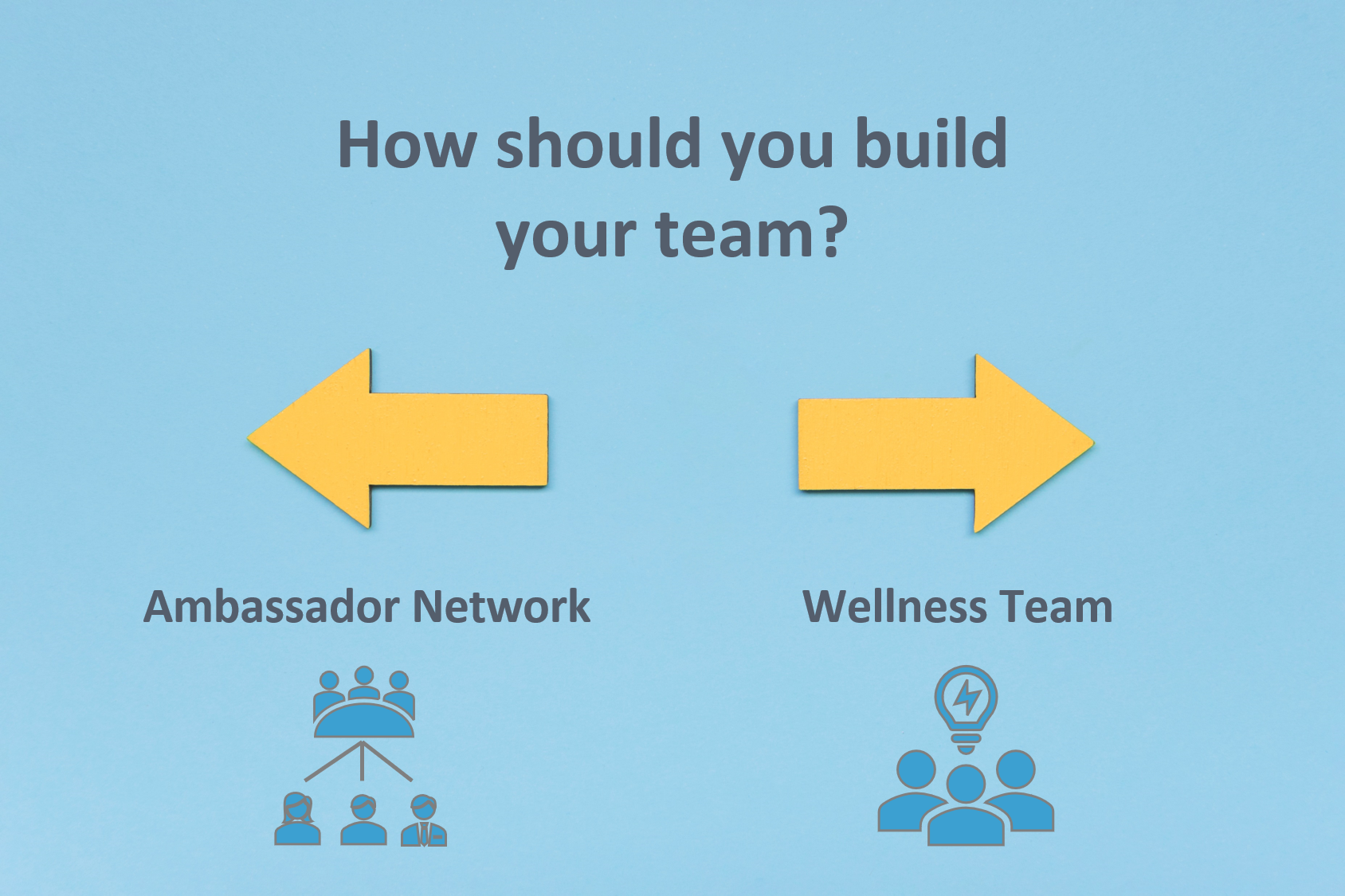In the pursuit of a healthier and more productive workplace, organizations have come to understand the paramount importance of employee well-being. Workplace wellness programs have emerged as a key strategy to nurture the health and happiness of the workforce. However, implementing and sustaining a successful wellness program demands effort and commitment. This is where the role of a wellness committee or a wellness champion team becomes instrumental. These dedicated groups play a vital role in supporting the wellness program and sharing the workload, ensuring its success in fostering a culture of well-being within the organization.
Let’s delve deeper into the reasons why having a wellness committee offers so much value:
Comprehensive Strategy Development: A wellness committee brings together a diverse group of individuals with varying perspectives, expertise, and experiences. This diversity allows for a holistic approach to be taken when developing wellness strategies. The committee can help identify the specific needs and interests of the workforce, ensuring that the program addresses a wide range of health and wellness concerns.
Employee Engagement: Involving employees in the design and decision-making process through the wellness committee increases their sense of ownership and commitment to the program. This heightened engagement leads to higher participation rates and greater overall success.
Sustainable Implementation: A dedicated wellness committee ensures that the workplace wellness program is not a one-off initiative but rather an ongoing effort. By continually evaluating the program’s effectiveness, the committee can make necessary adjustments, keeping the program relevant and sustainable in the long run.
Cultural Alignment: The wellness committee can help align the wellness program with the organization’s culture and values. This integration reinforces the importance of employee well-being, creating a healthier work environment where wellness is prioritized and celebrated.

When recruiting members for the wellness committee, there are some key qualities and characteristics that you should consider. Meaghan discusses this in more detail in the video above.
Building Your Wellness Committee
Recruiting the right members for a wellness committee is a crucial step in ensuring the success and effectiveness of a workplace wellness program. To create a dynamic and impactful team, organizations should aim to assemble a diverse cross-section of individuals from different departments, levels, branches, and backgrounds. Here are some qualities to look for:
Enthusiasm for Wellness: Look for people who genuinely believe in the value of wellness. They should be excited about the program as they will serve as advocates, motivating others to participate and embrace the wellness program.
Natural Leaders and Supporters: Identify employees who exhibit strong leadership qualities and possess a genuine desire to support and uplift their colleagues. These natural leaders can inspire and influence others within the organization, ensuring that wellness becomes a shared vision rather than a top-down initiative.
Communication Skills: Effective communication is vital for spreading awareness about wellness initiatives, garnering support, and ensuring employees understand the benefits of the program.
Organizational Skills: The committee will handle various tasks, from event planning to data analysis depending on the specifics of your program. Strong organizational abilities are critical for successful execution.
Empathy and Understanding: Empathetic committee members can better understand the diverse needs and challenges faced by employees, tailoring the program to meet these requirements effectively.
Involvement and Contribution: Look for employees who express a desire to be actively involved in shaping the organization’s culture. Those who are eager to contribute their time and efforts to building a healthier workplace will be dedicated and committed members of the committee.
When recruiting committee members, it’s crucial to communicate the purpose and goals of the wellness program clearly. Emphasize that their involvement will be instrumental in fostering a positive impact on the workforce’s health and happiness. Also, ensure that the commitment required is transparent, as maintaining an effective wellness program requires time, energy, and ongoing effort from committee members.

There are two ways to build your wellness committee and both can be very effective.
Building Your Wellness Committee: Two Approaches to Success
When setting up a wellness committee, organizations have the flexibility to adopt different approaches based on their unique culture, size, and goals. Each method comes with its own set of benefits and challenges.
The Steering Committee with Ambassadors
The Steering Committee approach involves establishing a core group of a few individuals who will act as the driving force behind the wellness program. They make the decisions about the program and work with a team of representatives from various departments or levels of the organization that helps promote the program’s overall vision, strategy, and goals.
Advantages:
- With a smaller team, the decision-making process can be more efficient, enabling quicker responses to emerging wellness needs and challenges.
- Each member of the steering committee can bring specific expertise or insights, enhancing the quality of program development.
- Ambassadors can customize wellness initiatives to cater to the specific needs of their colleagues in different departments or branches, fostering a more localized approach.
- Having ambassadors who are familiar faces and trusted members of their teams can encourage higher participation rates.
- Ambassadors provide valuable feedback to the steering committee, ensuring that wellness strategies remain relevant and effective across the organization.
The Unified Large Team
In this approach, organizations opt for a single large wellness committee that comprises representatives from various departments, levels, and branches. The idea is to involve as many employees as possible, creating a shared responsibility for executing the wellness program.
Advantages:
- Involving a larger group fosters a sense of collective ownership and shared commitment to the wellness program’s success.
- A larger team brings together a wide range of perspectives, ideas, and experiences, leading to more comprehensive wellness initiatives.
- Participation in the committee empowers employees and increases their engagement in the organization’s wellness efforts.
Some General Tips for Creating an Effective Wellness Committee
Strategic Recruitment: Plan your recruitment during ideal periods, such as January or February, when people are more inclined to consider health and wellness initiatives. The spring season is another opportune time. Leverage awareness periods like Healthy Workplace Month in October or Mental Health Awareness in May to promote committee membership.
Creative Promotion: Go beyond mere email communications and utilize various channels, like posters, internal newsletters, and social media to creatively promote committee membership. Avoid recruiting during busy organizational periods as employees may have limited capacity for additional responsivities. Instead, seize opportunities when you can engage with most employees, such as all-staff meetings or town halls.
Meeting Frequency: Start by meeting monthly to build momentum and camaraderie among committee members. As the program gains traction, you can shift bi-monthly meetings. However, remain flexible and adapt the meeting frequency to what works best for your organization’s needs and schedules.
Structured Meetings: Have a well-defined agenda for each meeting to ensure that discussions stay focused and productive. Keep minutes of the meetings to track ideas, progress, and action items. This will help the committee stay accountable and allow you to refer to previous discussions when needed.
Celebrate Successes: Incorporate positive roundtable opportunities during meetings to recognize and celebrate achievements, both big and small. Acknowledging the impact of the committee’s efforts will motivate team members and reinforce their dedication to the wellness program.
Encourage Feedback: Foster a culture of open communication and encourage team members to share feedback and insights from their observations. Listening to the perspectives of committee members helps identify potential areas of improvement and innovation for the wellness program.
Committee Size: Tailor the committee’s size to the organization’s scale. For companies with less than 100 employees, a committee of about 10 members is suitable, while organizations with fewer than 50 employees can work effectively with a committee of 5 members. Avoid the misconception that a larger committee is always better; a smaller team can promote more efficient decision-making and cohesive collaboration.
By following these tips, your wellness committee can help create a positive and supportive environment that drives the success of the workplace wellness program. Together you can foster employee well-being and build a thriving wellness culture within your organization.
Key Takeaways
1. How is your wellness committee or team organized? Who’s involved? Make sure the volunteers are passionate, supportive, and aligned with the collective direction of your program. Remember, having a diverse committee from different office locations, cities, branches, floors, leadership levels, and departments is crucial for inclusivity and success.
2. Decide on the preferred model – wellness ambassador network or a wellness champion team. The wellness ambassador network usually includes a small steering committee (responsible for decisions) and a group of ambassadors engaged in communication, team rallying, and encouraging optimal engagement. On the other hand, a wellness team often combines both decision-making and championing of the wellness program.
3. Establish the size of the wellness champion team. As a rule of thumb, for organizations with less than 100 members, consider 8-10% of the workforce. For those exceeding this threshold, aim for a team of 10-15 individuals. Remember, having too many cooks in the kitchen may not always yield the best results.
4. When is the ideal time to recruit members? Consider leveraging specific months during the calendar year for the best results. In Canada, October is recognized as Healthy Workplace Month, making it an excellent time to launch your workplace wellness initiative. Similarly, the start of the New Year and the spring season are also great opportunities to instill enthusiasm about health and wellness. Moreover, dedicating attention to forming a dynamic wellness team during Mental Health Week in May can be highly beneficial. However, if your business cycle is too chaotic during any of these times, it’s best to wait until there is adequate time to begin the recruitment process.
5. Effective communication with team members is crucial. Maintain a consistent meeting schedule (monthly or bi-monthly to begin with), providing an agenda and minutes. Kick-off each meeting with a “positive roundtable” to gather feedback on the progress made so far. Utilize this team as a feedback forum to reassess, reanalyze, and reignite the group’s enthusiasm.
Need some more assistance?
Get your FREE No-Obligation Strategy Session by emailing us today (info@ewsnetwork.com). Employee Wellness Solutions Network can help you create a healthier culture resulting in a more profitable and successful workplace. Our memberships give you access to services including corporate wellness specialists, trainers and health coaches to help you create the best strategy for your organization.
